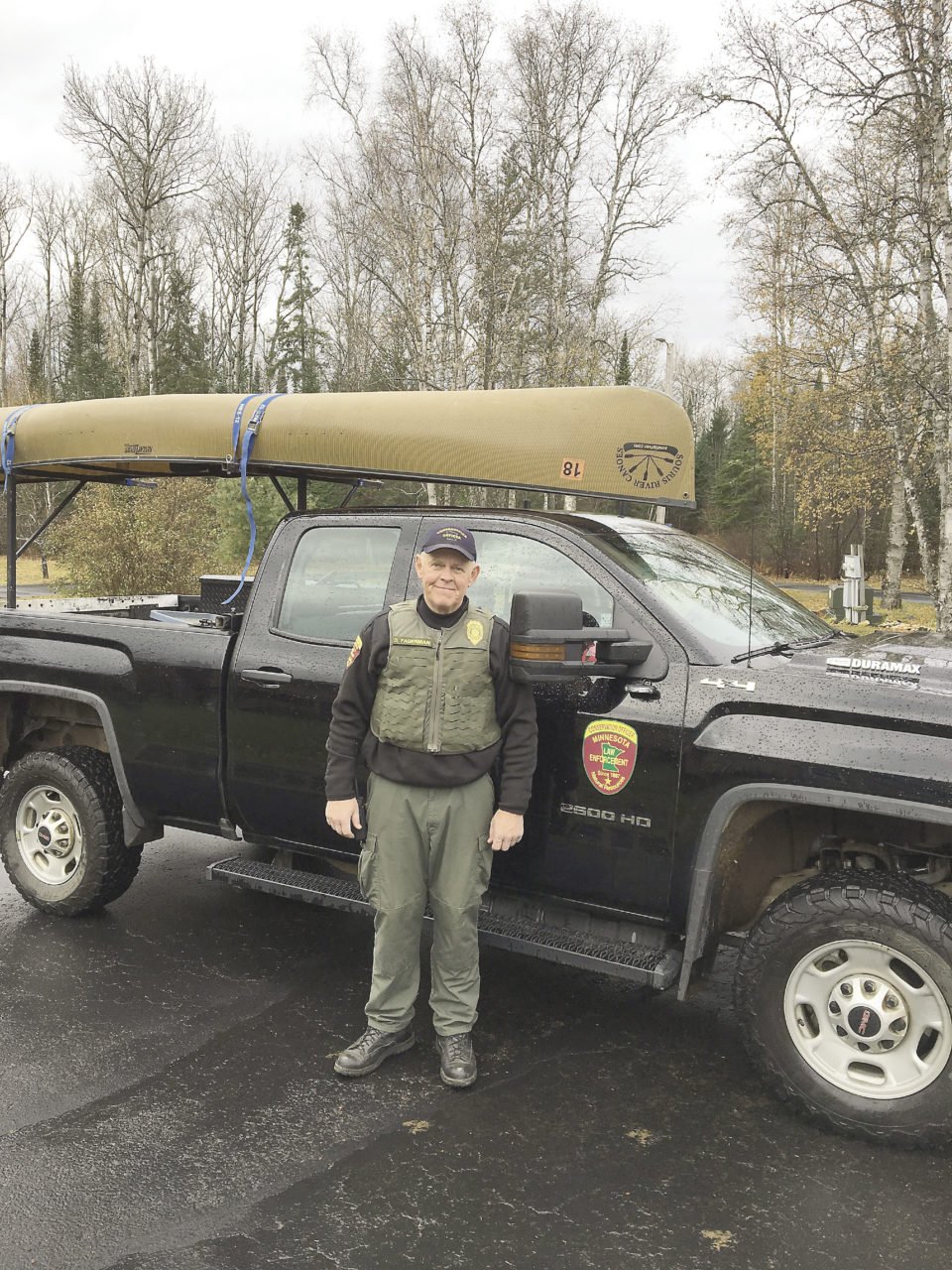Darin Fagerman of Grand Marais is getting ready to leave what he considers the best job in the state. His last day of work is June 29. After using up the remainder of his vacation time, he’ll then retire. In some respects, he’ll continue what he’s been doing; roaming the North’s woods and waters. The difference is that he’ll be doing so as an avid hunter and fisherman and no longer as a Minnesota conservation officer. For the last 15 years, he has been a familiar face to outdoor enthusiasts along the North Shore, up the Gunflint Trail and in the Boundary Waters, all of which are in his work area.
Although he always wanted to be a conservation officer, Fagerman began his career as a state trooper. In fact, this author interviewed the fresh-faced patrolman when he arrived in Grand Marais 30 years ago. Aside from a one-year transfer while a trooper, all of his career was spent in Grand Marais. He and his wife, Jennifer, raised their now-adult children, John and Sarah, there. When a conservation officer position opened in Cook County 15 years ago, he took the job.
Fagerman is one of the few old-school COs. Most of his work area is outside the range of cell phone and computer communications. In some spots, even his two-way radio doesn’t work. Since he frequently works alone in remote locations in all kinds of summer and winter weather, Fagerman has to be prepared for whatever happens, including spending an unplanned night in the woods. The latter hasn’t occurred, he says, but it’s been close.
“The worst was when I dropped the skis of my snowmobile through the ice on a beaver pond up on the Canadian border,” he says. “I managed to get it out and keep the engine dry, so I was able keep going. I had pushed the season a little.”
Given their line of work, COs often “push the season,” which means travelling in the backcountry during the iffy times of early winter and early spring when both the weather and ice conditions are unpredictable. On another occasion at Lake Saganaga, Fagerman fell through the ice into 21 feet of water as he stepped off his snowmobile. Fortunately, he had ice picks and was able to quickly pull himself up on the ice. Then he got back to business, which was finding illegal set lines put out by two poachers fishing for pike. Soaking wet, he returned to the two poachers, gave them a piece of his mind and tickets, then began a long snowmobile ride back to his truck. Luckily, the air temperature that April day was above freezing.
In winter, Fagerman says encounters with the “slush monster,” the mushy layer that often tops frozen lakes, prove challenging and potentially dangerous. Freeing a snowmobile that is bogged down in slush can be tremendously difficult. Usually insulated by a covering of snow, slush exists even in below-zero weather, quickly freezing to snowmobiles or snowshoes when exposed to the open air. Once, while snowshoeing across Boundary Waters lakes on a patrol, each of Fagerman’s snowshoes acquired 10-15 pounds of ice. When he returned to his snowmobile, he was unable to remove them and snowmobiled several miles back to his truck while wearing snowshoes. There he had to pound the ice off with a hammer until he was able to remove them.
While the North was once notorious for rampant poaching activity, the outlaws of the past are long gone. Ironically, one of the last incidences of illegal gill-netting on an inland lake was a net full of rotten walleyes, discovered and reported by an angler just a few days after the death of a well-known local poacher. Today’s violations mostly involve anglers trying to get away with something, such as an overlimit of fish, using extra lines, using live minnows on trout lakes where they are not allowed or keeping fish outside a slot limit. For deer hunting, using the tags of people who were not in field during the hunt and hunting over bait are common.
“We’re not making headway on baiting,” he says.
Egregious wildlife crimes still occur. Once, a group of partiers shot a lynx that wandered into the place where they were partying. They hid the carcass beneath a brushpile, which was subsequently burned. Four years later, Fagerman got a tip about the incident. Accompanied by a U.S. Fish and Wildlife Service officer, he investigated the site and recovered some bones, which were sent to a crime lab for analysis. When the bones were identified as lynx remains, the officers were able to make a case and get two convictions.
Fagerman’s work area includes many lakes along the Canadian border, many of which are in the Boundary Waters. Lakes accessible with motorboats or canoes are popular fishing waters. Minnesota and Ontario COs work joint patrols on these lakes. They are not cross-deputized, but may assist one another. One incident illustrates the practical nature of this arrangement. On North Lake, Fagerman encountered two boatloads of anglers with lake trout overlimits. In an attempt to avoid him, they motored into Canadian waters with Fagerman in pursuit. A short time later, the anglers unhappily discovered that he was accompanied by an Ontario CO.
While COs often encounter wrongdoers in the woods, they see good things, too. With the advent of inflatable PFDs, more people, including kids, are wearing them. Fagerman is also impressed with the respect most outdoor users in the North have for their surroundings. He said that opening day of the winter trout season may find 75 people ice-fishing on a lake. When they leave, he says, you would be hard-pressed to find a gum wrapper left behind.
On the other hand, COs encounter all kinds of wildlife during their travels, which gives them unique insight. This winter, for instance, Fagerman traveled over 2,000 miles via snowmobile and noticed fewer wolf tracks than he expected. When the snow is deep, as it was this winter, wolves follow snowmobile trails. Conversely, he saw more moose during the last year than he’d seen in the previous four or five years combined.
“Moose are starting to filter back into places where I haven’t seen them in a long time,” he said.
While he’s seen far more lynx over the years than bobcats, two winters ago four of the latter were hanging around the suet feeders at his home. Three bobcats were bold enough to sleep on his deck and peer through the glass sliding door to look at the television and his yellow Lab. He’s seen one positive game camera picture of a large cougar and his wife, Jennifer, once took pictures of a cougar track in the snow behind their home, shortly after there was an unverified sighting of a cat nearby. Among the more curious unverified sightings occurred early in his career, when a caribou was seen twice within a week near Five Mile Rock on Highway 61.
Over the years, he’s seen some changes in how people enjoy the outdoors. Trapping appears to be dying out, in part due to low fur prices. Driving along the backroads its now not unusual to encounter mountain bikers. Sometimes, he’ll snowshoe three or four miles into the Boundary Waters, only to find folks who are out there purely for enjoyment.
“The only hole they have in the ice is for water,” he says.
While some COs warned him that the job would make him lose interest in hunting and fishing, that hasn’t been the case. He often comes home from work, hooks up his personal boat and goes fishing. He bowhunts for deer and turkeys, travels to Canada to ice-fish for lake trout, makes long walks to hunt ruffed grouse and fishes everywhere from the Boundary Waters to Lake Superior.
“I’m out in the woods almost every day,” he says. “If I’m not working, I’m out hunting or fishing.”
Pretty soon, he’ll devote all of his time to hunting and fishing.






